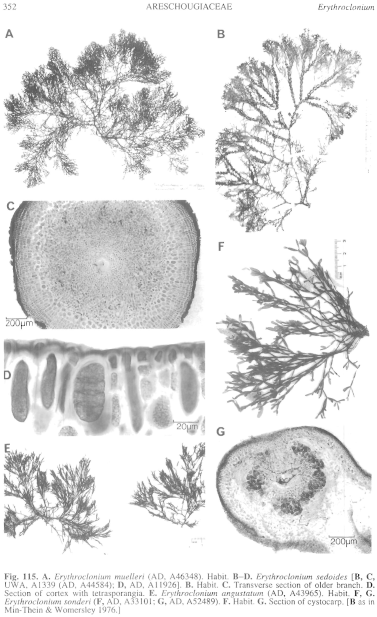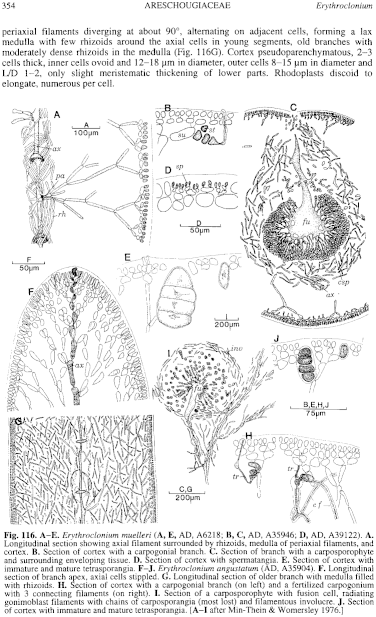|
|
|
|
|
|||||||||||
|
Electronic Flora of South Australia Species Fact Sheet
Phylum Rhodophyta – Class Florideophyceae – Order Gigartinales – Family Areschougiaceae
Selected citations: J. Agardh 1876: 278; 1894: 123, pl. 2 fig. 12. Kützing 1869:14, pl. 37c-f. Kylin 1932: 36. Lucas & Perrin 1947: 169. Min-Thein & Womersley 1976: 83, figs 29, 30, 60B.
Synonym
Axosiphon verticillata Areschoug 1854: 22.
Thallus (Fig. 115E) medium to dark red, 5–15 cm high, much branched with narrow, almost linear, constricted segments (3–) 4–10 mm long, (250–) 400–800 µm in diameter, with 2–5 branches from segment apices, lower branches only slightly thickened. Holdfast branched, with rhizoidal attachment pads; epiphytic on Amphibolis and Posidonia, occasionally epilithic. Structure (Fig. 116F) uniaxial, with each axial cell producing two periaxial filaments diverging at about 90°, alternating on adjacent cells, forming a lax medulla with few rhizoids around the axial cells in young segments, old branches with moderately dense rhizoids in the medulla (Fig. 116G). Cortex pseudoparenchymatous, 2–3 cells thick, inner cells ovoid and 12–18 µm in diameter, outer cells 8–15 µm in diameter and L/D 1–2, only slight meristematic thickening of lower parts. Rhodoplasts discoid to elongate, numerous per cell.
Reproduction: Sexual reproduction non-procarpic. Carpogonial branches (Fig. 116H) 3-celled, borne on outer medullary cells, directed inwards with reflexed trichogynes, rarely with a sterile cell on the basal cell. Connecting filaments (Fig. 116I) 1 (–3), non-septate apart from next to the carpogonium, usually unbranched. Auxiliary cell an outer medullary cell with adjacent cortical cells forming chains of small, darkly staining nutritive cells. Gonimoblast initial inwards, developing a prominent stalked fusion cell (Fig. 116I) with radial gonimoblasts producing chains of ovoid carposporangia 30–50 µm in diameter. Cystocarps lying within the medulla, with filamentous enveloping tissue, slightly swelling the segments, ostiolate. Spermatangia unknown.
Tetrasporangia (Fig. 116J) scattered in the cortex of young segments, developed from inner cortical cells and pit-connected laterally, protruding into the medulla, ovoid, 50–70 µm long and 22–30 [un in diameter, zonately divided.
Type from Lefevre Peninsula, S. Aust. (Mueller, July 1852); lectotype in MEL, 44494, isolectotypes 44720,44732 and AD, A45065.
Selected specimens: Point Sinclair, S. Aust., drift (Womersley, 25.i.1951; AD, A13880). Elliston Bay, S. Aust., 3 m deep on Amphibolis (Shepherd, 20.x.1970; AD, A37535). Somerton Beach, S. Aust., drift (Womersley, 4.iii.1944; AD, A1631). Normanville Beach, S. Aust., drift (Min-Thein, 7.vi.1970; AD, A35904). Pennington Bay, Kangaroo I., S. Aust., drift (Kraft & Min-Thein, 3.xii.1971; AD, A41386). Victor Harbor, S. Aust., drift (Womersley, 24.vii.1949; AD, A11146). Robe, S. Aust., 8 m deep (P. Womersley, 24.viii.1973; AD, A43965). Point Roadknight, Vic., drift (Sinkora, A1414, 29.xi.1971; AD, A43119). Point Lonsdale, Vic., drift (Hansen, Jan. 1954; AD, A20443). Phillip I., Vic. (Mueller, Feb. 1863; MEL, 44727, 44731).
Distribution: Point Sinclair, S. Aust., to Phillip I., Vic.
Taxonomic notes: Erythroclonium angustatum is the slenderest Australian species of the genus and the only one to occur mainly on the seagrasses Amphibolis and Posidonia.
References:
AGARDH, J.G. (1876). Species Genera et Ordines Algarum. Vol. 3, Part 1 - Epicrisis systematis Floridearum, pp. i-vii, 1–724. (Weigel: Leipzig.)
AGARDH, J.G. (1894). Analecta Algologica. Cont. II. Acta Univ. lund. 30, 1–98, Plate 1.
ARESCHOUG, J.E. (1854). Phyceae novae et minus cognitae in maribus extraeuropaeis collectae. Ups. Soc. Sci. nova Acta, Ser. III, 1, 329–72.
KÜTZING, F.T. (1869). Tabulae Phycologicae. Vol. 19. (Nordhausen.)
KYLIN, H. (1932). Die Florideenordnung Gigartinales. Lunds Univ. Årsskr. N.F. Avd. 2, 28 (8), 1–88, Plates 1–28.
LUCAS, A.H.S. & PERRIN, F. (1947). The Seaweeds of South Australia. Part 2. The Red Seaweeds. (Govt Printer: Adelaide.)
MIN-THEIN, U. & WOMERSLEY, H.B.S. (1976). Studies on southern Australian taxa of Solieriaceae, Rhabdoniaceae and Rhodophyllidaceae (Rhodophyta). Aust. J. Bot. 24, 1–166.
SONDER, O.W. (1853). Plantae Muellerianae. Algae. Linnaea 25, 657–709.
SONDER, O.W. (1855). Algae annis 1852 et 1853 collectae. Linnaea 26, 506–528.
The Marine Benthic Flora of Southern Australia Part IIIA complete list of references.
Publication:
Womersley, H.B.S. (14 January, 1994)
The Marine Benthic Flora of Southern Australia
Rhodophyta. Part IIIA, Bangiophyceae and Florideophyceae (to Gigartinales)
Reproduced with permission from The Marine Benthic Flora of Southern Australia Part IIIA 1994, by H.B.S. Womersley. Australian Biological Resources Study, Canberra. Copyright Commonwealth of Australia.
Illustrations in Womersley Part IIIA, 1994: FIGS 115E, 116 F–J.

Figure 115 enlarge
Fig. 115. A. Erythroclonium muelleri (AD, A46348). Habit. B–D. Erythroclonium sedoides [B, C, UWA, A1339 (AD, A44584); D, AD, A11926]. B. Habit. C. Transverse section of older branch. D. Section of cortex with tetrasporangia. E. Erythroclonium angustatum (AD, A43965). Habit. F, G. Erythroclonium sonderi (F, AD, A33101; G, AD, A52489). F. Habit. G. Section of cystocarp. [B as in Min-Thein & Womersley 1976.]

Figure 116 enlarge
Fig. 116. A–E. Erythroclonium muelleri (A, E, AD, A6218; B, C, AD, A35946; D, AD, A39122). A. Longitudinal section showing axial filament surrounded by rhizoids, medulla of periaxial filaments, and cortex. B. Section of cortex with a carpogonial branch. C. Section of branch with a carposporophyte and surrounding enveloping tissue. D. Section of cortex with spermatangia. E. Section of cortex with immature and mature tetrasporangia. F–J. Erythroclonium angustatum (AD, A35904). F. Longitudinal section of branch apex, axial cells stippled. G. Longitudinal section of older branch with medulla filled with rhizoids. H. Section of cortex with a carpogonial branch (on left) and a fertilized carpogonium with 3 connecting filaments (on right). I. Section of a carposporophyte with fusion cell, radiating gonimoblast filaments with chains of carposporangia (most lost) and filamentous involucre. J. Section of cortex with immature and mature tetrasporangia. [A–I after Min-Thein & Womersley 1976.]

|
Email Contact: State Herbarium of South Australia |

|